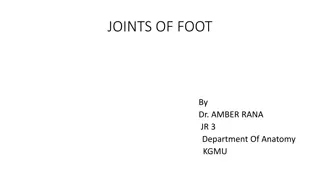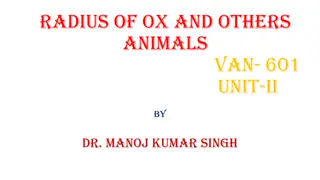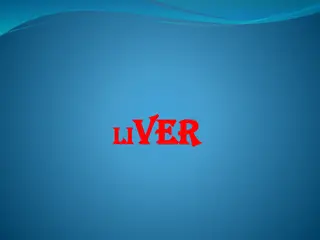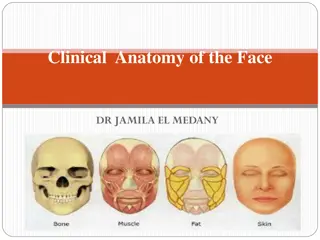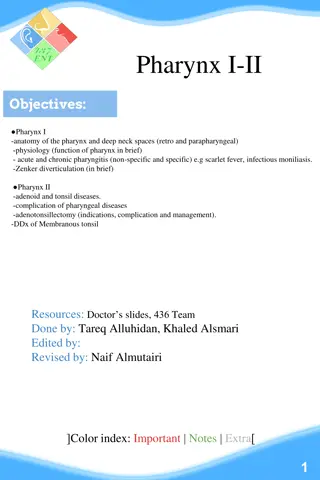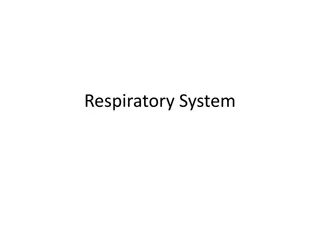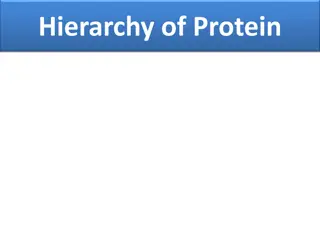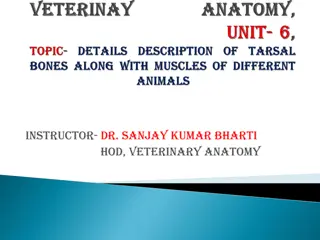Anatomy of the Pharynx: Structure and Function
The pharynx is a musculomembranous tube that connects the nasal and oral cavities to the larynx and esophagus. It is divided into three parts: nasopharynx, oropharynx, and laryngopharynx, each with unique features and functions. Muscles like pharyngeal constrictors and palatopharyngeus play a crucial role in swallowing and phonation. Nerve and blood supply, as well as lymph drainage, are essential for the proper functioning of the pharynx.
Download Presentation

Please find below an Image/Link to download the presentation.
The content on the website is provided AS IS for your information and personal use only. It may not be sold, licensed, or shared on other websites without obtaining consent from the author.If you encounter any issues during the download, it is possible that the publisher has removed the file from their server.
You are allowed to download the files provided on this website for personal or commercial use, subject to the condition that they are used lawfully. All files are the property of their respective owners.
The content on the website is provided AS IS for your information and personal use only. It may not be sold, licensed, or shared on other websites without obtaining consent from the author.
E N D
Presentation Transcript
Diyala University College of Medicine Department of Anatomy and Histology Anatomy Lab Second Semester \ Second Stage The Larynx and Pharynx Presented by Msc. Dr. Reham Saad Dr. Mohaiman Al wazan
Pharynx Musculomembranous tube, connects the nasal and oral cavity in the head with the larynx and esophagus in the neck. Location : lying under the skull, and situated behind the nasal cavities, the mouth, and the larynx. Shape : funnel shaped , wider upper end, and narrow lower end which is continuous with the esophagus at C6. Its wall is deficient anteriorly , where replaced by posterior openings of the nose, mouth and of the larynx 1.Nasopharynx: 2. Oropharynx: 3 . Laryngopharynx.
Parts of the pharynx: Nasopharynx 1.Nasopharynx: Behind the nasal cavities , it extends from base of skull to the upper surface of soft palate The Features of Nasopharynx Auditory tube open on the lateral wall, with tubal elevation . pharyngeal recess: vertical gutter behind opening of the auditory tube. Salpingopharyngeal fold , produced by underlying salpingopharyngeal muscle . 2. Oropharynx : Lies behind the mouth cavity, its floor formed by posterior one third of the tongue. The features of Oropharynx : medianglossoepiglottic fold , with depression on each side of this fold called vallecula. On its lateral wall there are palatoglossal and palatopharyngeal arches, with the palatine tonsils between them
3 .Laryngopharynx: lies behind the opening of the larynx, it extends from upper border of the epiglottis to the level of the cricoid cartilage(c6), where it become continuous with the esophagus. Lateral wall is formed by the thyroid cartilage and thyrohyoid membrane.
Muscles of the pharynx: 1.Pharyngeal constrictors: Superior, middle and inferior constrictor muscles, run in circular direction, around the pharyngeal wall, the three muscles overlap each other , in the way the middle lies outside the lower part of the upper and so on . 2. Palatopharyngeus pass from palate , down, internal to the superior constrictor, and to be inserted into posterior border of the thyroid lamina . it rises the larynx, pharynx, and arches the palate. 3. salpingopharyngeus from lower part of the cartilage of auditory tube , down and blend with palatopharyngeus 4. Stylopharyngeus from styloid process, and passes inside the middle constrictor to be inserted with palathopahryngeus into thyroid lamina.
Nerve supply : All muscles of pharynx are supplied by the pharyngeal plexus except stylopharyngeus supplied by glossopharyngeal nerve Blood supply : 1.Ascending pharyngeal artery . 2. tonsillar branch of facial. 3. branches of maxillary and lingual arteries. Lymph drainage: Directly into deep cervical LN
Waldersring : A collection of ,lymphoid tissue located at the junction of the mouth with the oral part of pharynx, and at the junction of the nose with the nasal part of pharynx, they are part of body immune system. The palatine tonsils Located within tonsillar fossa, between the palatoglossal and palatopharyngeal arches just posterior to oropharyngeal isthmus. The floor of the fossa is the superior constrictor of the pharynx with tonsillar capsule and a film of loose CT in between, it is covered by stratified squamous epithelium, pitted by crypts up to twenty, and deep intratonsillar cleft
Blood supply : Arterial 1.Tonsillar branch of facial artery , enters the gland by pricing the superior constrictor. 2 .Ascending palatine artery. 3. Ascending pharyngeal artery . Venous drainage form plexuses around , price the superior constrictor into pharyngeal plexus, it has one large vein called external palatine or paratonsillar vein 28 Nerve supply : mm over the tonsil is by tonsillar branch of glossopharyngeal nerve. 2. pharyngeal tonsil : Location: in the midline in submucosa of the roof the nasopharynx . When become large in children known as adenoids. 3. Other small lymphoid : 1.Lingual tonsil. 2.Tubal tonsil. 3. Lateral band
LARYNX Location: lies at the level of C4,5,6. Opens above into the laryngeal part of pharynx, and continuous with trachea below. Structure: Cartilages of larynx: Single : 1.Thyroid cartilage 2.Cricoid cartilage 3.Epiglottis Paired : 1.Arytenoid. 2.Corniculate . 3.cuneiform .
1. Single cartilages 1.Thyroid cartilage : largest, it consists of two lamina of hyaline cartilage, that meet in midline in prominent V angle. its posterior border extends upward into a superior horn and downward into a inferior horn. The outer surface of each lamina has oblique line for the attachment of muscles 2.Cricoid cartilage: Formed of hyaline cartilage, it has a shape of a signet ring, with broad plate behind and a shallow arch in front. It lies below thyroid cartilage, it has a fact for articulation with its inferior horn, and facet for articulation with arytenoid cartilage on its upper border 3.Epiglottis Leaf-shaped lamina of elastic cartilage , lies behind the root of the tongue. Stalk of the leaf attached to the back of thyroid cartilage. sides attached to the aryepiglottic folds. upper end is free. medianglossoepiglottic fold, pass to the posterior surface of the tongue, and laterally passes onto the wall of the pharynx as lateral glossoepiglottic fold.
2. Paired Cartilages 1.Arytenoid cartilage Two small, pyramid in shape and located at the back of the larynx. Apex above and articulates with corniculate cartilage. base below and articulates with lamina of the cricoid cartilage. It has a vocal process that projects forward and give attachment to vocal ligament. muscular process that projects laterally and gives attachment to the posterior and lateral cricoarytenoid muscles 2.Corniculate : Two small conical in shape , articulates with arytenoid cartilage and give attachment to the aryepiglottic fold. 3.Cuneiform : tiny and lies in the aryepiglottic fold, they are unimportant
Membranes and ligaments of larynx : 1.Thyrohyoid membrane: connects the upper margin of the thyroid cartilage to hyoid bone, it is pierced on each side by the superior laryngeal vessels and the internal laryngeal nerve . 2.Thyrohyoid ligament : Thickened median part of the thyrohyoid membrane. ( median anterior and lateralposterior ) 3.Cricotracheal ligament : connects the cricoid cartilage to first trachea ring. 4.Cricothyroid Ligament: Attached to upper border of cricoid cartilage, it has free upper margin, composed entirely of elastic tissue, and attached to thyroid cartilage anteriorly and to vocal process of arytenoid cartilage posteriorly , forming vocal ligament, which forms the interior of vocal fold ( vocal cords)
Laryngeal folds 1. Aryepiglottic fold 2.Vocal Folds ( vocal cords): Vocal ligament (upper free margin of cricothyroid ligament) with its mm covering. white, avascular and mobile . Concerned with voice production. Gap between the two sides is called the rima glottis, it is the narrowest part of the larynx , 3. Vestibular Fold formed of vestibular ligament, covered by mm, located on each side of the larynx. Fixed, vascular and pink in colour.
Cavity of larynx: Extends from inlet to lower border of cricoid cartilages, where it continues with trachea, it is divided into three regions. 1.Supraglottic space ( vestibule) between inlet and the vestibular fold. 2. Transglottic space (Laryngeal cavity). between the vestibular fold and the vocal folds. 3. Subglottic space : between vocal folds and lower border of cricoid cartilages below.
Extrinsic muscles : 1.move the larynx as a whole ,up and down during swallowing. Elevation: digastric, stylohyoid, mylohyoid, geniohyoid, and stylopharyngeus muscles. salpingopharyngeus, and palatopharyngeus. Depression : Sternothyroid, Sternohyoid, and omohyoid muscles. 2. Move cartilages of larynx relative to one another: Cricothyroid : has straight and transverse parts, it tightens the vocal folds. Intrinsic muscles: 1. for modifying the laryngeal inlet. 1.narrowing laryngeal inlet :Oblique arytenoid muscle . 2.Widening laryngeal inlet thyroepiglotticmuscle .
Nerve supply of the larynx Sensory : Above the v.c: internal laryngeal branch of superior laryngeal , branch of vagus. Below the v.c: Recurrent laryngeal nerve. Motor : All intrinsic muscle supplied by the recurrent laryngeal nerve except cricothyroid mucles which is supplied by external laryngeal, branch of the superior laryngeal , branch of vagus nerve Blood supply of larynx Upper half of the larynx: by superior laryngeal branch of the superior thyroid artery. Lower half of the larynx: by the inferior laryngeal branch of the inferior thyroid artery . Lymph drainage of larynx Into Deep Cervical LN





